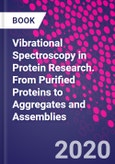Vibrational Spectroscopy in Protein Research offers a thorough discussion of vibrational spectroscopy in protein research, providing researchers with clear, practical guidance on methods employed, areas of application, and modes of analysis. With chapter contributions from international leaders in the field, the book addresses basic principles of vibrational spectroscopy in protein research, instrumentation and technologies available, sampling methods, quantitative analysis, origin of group frequencies, and qualitative interpretation. In addition to discussing vibrational spectroscopy for the analysis of purified proteins, chapter authors also examine its use in studying complex protein systems, including protein aggregates, fibrous proteins, membrane proteins and protein assemblies.
Emphasis throughout the book is placed on applications in human tissue, cell development, and disease analysis, with chapters dedicated to studies of molecular changes that occur during disease progression, as well as identifying changes in tissues and cells in disease studies.
Please Note: This is an On Demand product, delivery may take up to 11 working days after payment has been received.
Table of Contents
1. ATR-FTIR Spectroscopy and Spectroscopic Imaging of Proteins 2. Light-Induced Difference FTIR Spectroscopy of Photoreceptive Proteins 3. Quantum Cascade Laser-based IR Transmission Spectroscopy of Proteins in Solution 4. Theoretical Simulation of Protein Two-Dimentional Infrared Spectroscopy 5. Infrared Spectroscopy and Imaging for Understanding Neurodegenerative Protein-Folding Diseases 6. Near-infrared (NIR) spectroscopy in protein research 7. Vibrational imaging of proteins: changes in the tissues and cells in the lifestyle disease studies 8. Interpretation of Vibrational Optical Activity Spectra of Proteins 9. Nano-scale analysis of protein self-assemblies 10. Vibrational Spectroscopic Analysis and Quantification of Proteins in Human Blood Plasma and Serum 11. Vibrational spectroscopy in protein research towards virus identification: challenges, new research and future perspectives 12. Two-Dimensional Correlation Spectroscopy of Proteins 13. Resonance Raman spectroscopy of hemoglobin in red blood cells 14. Ultraviolet Raman spectroscopy for understanding structure and formation mechanism of amyloid fibrils 15. Recent advances in Raman spectroscopy of proteins for disease diagnosis 16. Dynamics and allostery of human hemoglobin as elucidated by time-resolved resonance Raman spectroscopy 17. Immuno-SERS: from nanotag design to assays and microscopy 18. Highly localized characterization of protein structure and interaction by surface-enhanced Raman scattering 19. Surface-enhanced Raman scattering (SERS) chemosensing of proteins








